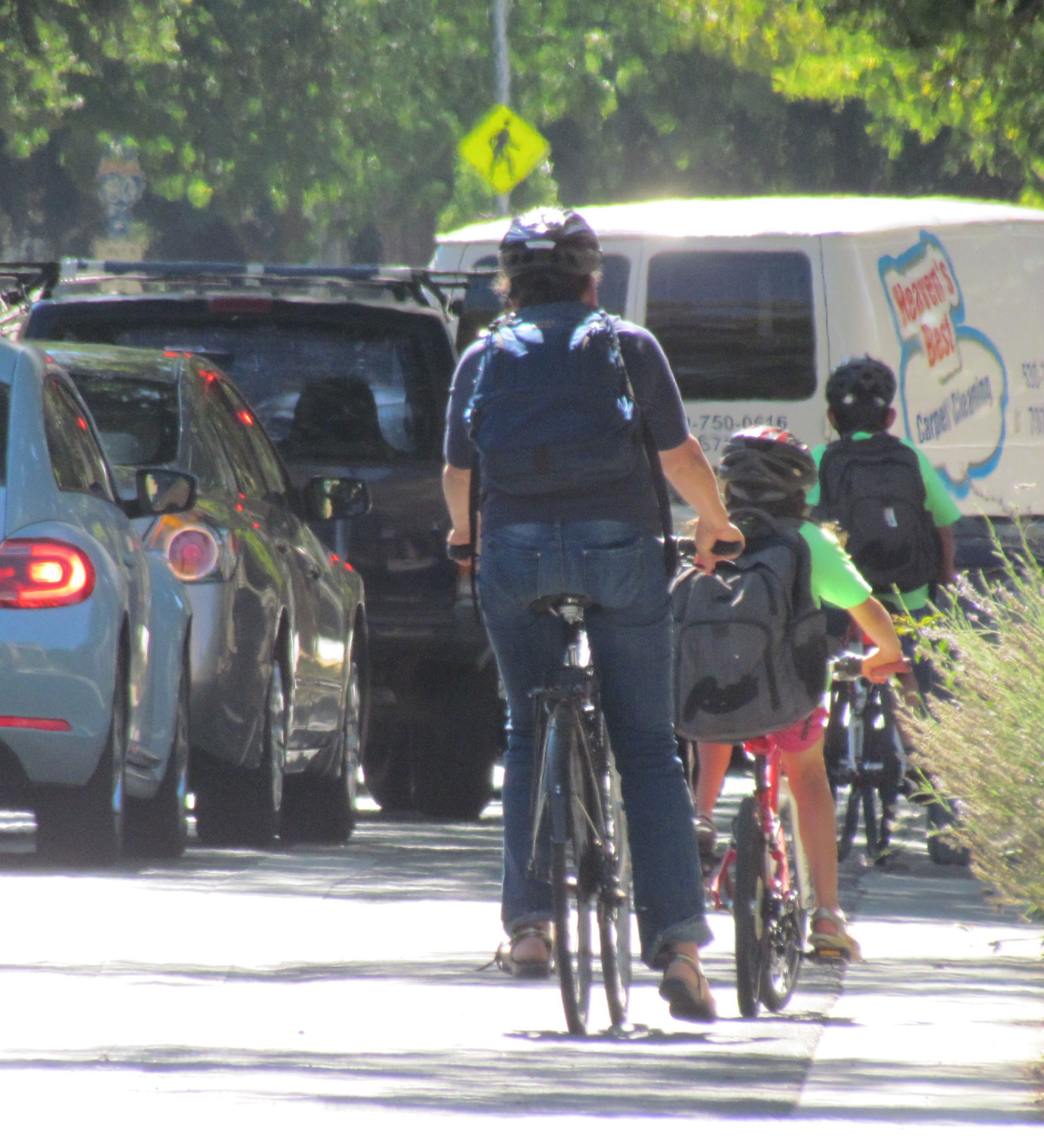Questions, and Some Answers, About Caltrans’ New Complete Streets Directive
3:23 PM PST on January 14, 2022

If we want people to drive less and use active modes more, we need to make sure our transportation funding plans reflect that. Photo: Melanie Curry/Streetsblog
Note: GJEL Accident Attorneys regularly sponsors coverage on Streetsblog San Francisco and Streetsblog California. Unless noted in the story, GJEL Accident Attorneys is not consulted for the content or editorial direction of the sponsored content.
Caltrans recently issued a new Complete Streets directive that commits the state transportation department to including "complete streets elements" in all of its projects. The announcement has been received with interest - heavily tempered with skepticism - by bike and safety advocates who have long experience working with Caltrans.
The deeply embedded notion that cars must always be accommodated and other road users must work around them has erected seemingly endless bureaucratic barriers to safer street designs, and advocates wonder if it is even possible to shift that.
Newly appointed Deputy Director of Sustainability at Caltrans, Tony Dang, knows a bit about this. He's the former Executive Director of California Walks, the statewide coalition advocating for better pedestrian safety. He has been leading the work to engage Caltrans division and district heads on developing the Complete Streets directive for a while.
"I get the skepticism," he told Streetsblog in a recent interview. "Having been on the outside - and now being on the inside - I have to say that this is the first time I've felt a lot of hope" for change at Caltrans.
This is because Caltrans is in the midst of a huge culture shift. It's been happening for a long time, in fits and starts. An earlier version of a Complete Streets policy was issued in 2014, around the time that Caltrans was facing pressure from Governor Brown to change its "hidebound bureaucratic ways." A strategic planning process created a whole new philosophy for Caltrans, which no longer called itself the Highway Department and even set ambitious goals for increasing walking, biking, and transit use in California.
Not exactly sure how to go about that, Caltrans began by hiring a bike and pedestrian safety chief and started asking how it could track and respond to pedestrian injuries on and near its roads.
All of this was laying groundwork, but not producing much change on the streets. The mode share goals were ambitious but came nowhere near to being met, nor have they been publicly updated. Senator Scott Wiener's Complete Streets bill in 2019 tried to force Caltrans to take its own policies seriously. The bill got all the way through the legislature before it was vetoed by Governor Newsom under pressure from Caltrans, which claimed it would be "too expensive" to comply with.
It sure sounded like they were saying the lives and safety of people on foot and on bikes were just "too expensive" to protect.
That bill, though it didn't pass, still had a powerful effect. At the same time Newsom was vetoing S.B. 127, he was hiring a new Caltrans director who has solid active transportation credentials, a dramatic difference from previous leadership. That new Director, Toks Omishakin, knew that the Complete Streets issue was not going away; Senator Wiener's bill, though unsuccessful, forced Caltrans to back up its assertion that S.B. 127 wasn't necessary. He called for $100 million to be set aside for Complete Streets in the State Highway Operation and Protection Program and put his staff onto identifying projects that could use the money. Meanwhile he increased the size of Caltrans' Sustainability division, found more funding and staff to work on pedestrian and bicycle safety, and has continually stated that Caltrans is ending the era of highway expansion.
Dang says all these changes have led to a shift in terms of how serious the department is about complete streets. There used to be about one person charged with working on sustainability, complete streets, and bike and pedestrian safety, and now there is not only a separate branch at headquarters specifically focused on these issues, but there are people in every division, such as design, whose job is to keep these issues at the forefront.
"The policy was not developed in a silo at headquarters," said Dang. "We have spent a fair amount of time engaging with district colleagues, and we have the buy-in of our executive team around both the vision of this policy and seeing it through to implementation. Our district directors are committed as well; they know this is the direction Caltrans is headed."
And while Dang acknowledged that "absolutely it's healthy to have skepticism," he also thought some of the advocates' claims that "we've heard this all before" are "a little unfair."
"This is the first time Caltrans is signaling that an organizational priority is to support walking, biking, transit, and rail. Caltrans has never said that before," he said. Also for the first time, Caltrans is recognizing that streets are "valuable community spaces," beyond their use as traffic conduits, and is committing to prioritizing communities that have been harmed by past infrastructure decisions. "These are things the department had never said, not in such an explicit way," said Dang.
The 2014 policy was much less direct and explicit about what actions were expected from Caltrans staff, and it did not center walking and biking, said Dang. The new policy is "much more directive," and was immediately followed by a list of priority actions with deadlines ranging into next year [PDF].
Of course, Dang acknowledged, "actions speak louder than words."
But therein lies another rub. Although the changes in the past eight or so years at Caltrans may seem substantive within the department, it still looks a lot like the same-old same-old to people outside of it. And part of that is because, as Dang pointed out, transportation projects tend to have a very long timeline, from conception through planning and design and construction.
"They take a very long time to even get to the later stages," said Dang, "and the further along a project is in the development process, the more difficult it is to change it. That's not to say we're not doing our best to change those projects" that need to include complete streets elements. It's just harder.
But "for projects that are very early on, or haven't even been conceived yet, the conversation will be changed completely," he said.
This is where advocates have many concerns. The climate crisis is already upon us, and people who are trying to get more people biking and walking are frustrated by the slow action to make that possible by creating safer spaces. We need these changes now - and we need to stop widening highways and destroying homes now, not at some long-timeline future date.
Another big question is how the exception process for this complete streets policy will work. That is, if it requires some kind of complete streets element "on every Caltrans project" going forward, how will exceptions be made, discussed, and documented? Some advocates are skeptical that this will be a transparent process, based on their experience advocating for safer street designs.
One difference with the new directive, according to Dang, is that the final responsibility for approving exceptions rests with the District Directors. That is new - usually exceptions to Caltrans standards are dealt with at the staff and project team level.
"Elevating this to an executive level - wherein district directors will be directly involved in those sign-offs - will change the conversation as well," he said, calling it "a game changer." "The district directors are setting an expectation, and headquarters will hold district directors accountable for seeing this through," he added.
Dang recognizes that transparency has been a problem, but says Caltrans is addressing it. Regular updates to the Caltrans Complete Streets Action Plan will begin in the fall, for example, as required by a list of "priority actions" to accompany the new directive. "One of our implementation steps is to be more clear and transparent about what we're working on, and what our deadlines are," said Dang.
"We recognize the history hasn't been great," said Dang. "But we're committing to removing these procedural barriers, and we're working toward figuring out how to work better with our local partners to do what needs to be done. We don't want to be the reason why good work isn't done."
Caltrans has changed, but it has also stayed the same in many ways, and many local planners and engineers, not to mention advocates, have been worn down by the department's barriers to common sense. And if local jurisdictions don't even want to start a conversation about something they think will be "too hard to get Caltrans approval on," it will take more than a single policy directive to convince people.
For more on this topic, tune in to Bike Talk on Tuesday for another interview with Tony Dang, this one by Dave Campbell of Bike East Bay.
Streetsblog California editor Melanie Curry has been thinking about transportation, and how to improve conditions for bicyclists, ever since commuting to school by bike long before bike lanes were a thing. She was Managing Editor at the East Bay Express, editor of Access Magazine for the University of California Transportation Center, and earned her Masters in City Planning from UC Berkeley.
Stay in touch
Sign up for our free newsletter
More from Streetsblog California
State E-bike Incentive Program Update
E-bike battery certification requirements, and get ready now for the first launch window.
Commentary: Merchants Are Getting People Killed
The number one local obstruction to curbing traffic violence is local commerce and merchant groups.
Freeway Drivers Keep Slamming into Bridge Railing in Griffith Park
Drivers keep smashing the Riverside Drive Bridge railing - plus a few other Griffith Park bike/walk updates
Wednesday’s Headlines
Bike Month begins; Transit dangers; Yolo causeway project "not air quality concern" and Sacramento gets an F in air quality; Universal basic income could get a lot of people off the streets; More




